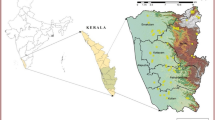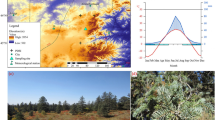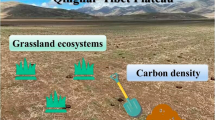Abstract
Climate change can significantly affect carbon cycling of forest ecosystems. The diurnal and seasonal dynamics of soil respiration (R s) in Cinnamomum camphora and Liquidambar formosana forests were investigated by using infrared gas exchange analyzer of Li-Cor 6400-09 each month in 2006. Soil temperature and moisture were also measured. Diurnal variations in R s varied with daily soil temperature in the two forests. Across the growing season, soil respiration peaked on July 28 due to higher soil temperature and moisture conditions. Seasonal R s variations were predominantly influenced by soil temperature. Seasonal soil respirations in C. camphora and L. formosana forests were strongly related to soil temperature (x) at 5-cm depth (R s = 0.1598e0.1377x (R 2 = 0.9289, P = 0.001) and R s = 0.2177e0.0962x (R 2 = 0.927, P = 0.000)), while annual mean R s rate was 2.614 and 1.397 μmol m−2 s−1 and Q 10 values was 3.96 and 2.62 for the two forests, respectively. However, R s was not influenced by seasonal changes in soil moisture (w) in the two forests in 2006. We developed two equations (R s = −0.020w 2+0.497w+0.562 (R 2 = 0.109, P > 0.05), R s = −0.001w 2+0.072w+0.731(R 2 = 0.053, P > 0.05)) to describe the relationship between R s and soil moisture. A positive relationship between R s and soil moisture were observed when soil moisture was below 12.43% and 18.00%, but when soil moisture exceeded threshold values of 12.43% and 18.00%, soil moisture became the restraint factor for R s. Long-term observations of soil respiration and moisture are required to understand the temporal dynamics of soil respiration.
Similar content being viewed by others
References
Raich J W, Schlesinger W H. The global carbon dioxide flux in soil respiration and its relationship to climate. Tellus, 1992, 44: 81–99
Davidson E A, Janssens I A, Luo Y Q. On the variability of respiration in terrestrial ecosystems: moving beyond Q 10. Glob Change Biol, 2006, 12: 154–164
Schimel D S. Terrestrial ecosystem and the carbon cycle. Glob Change Biol, 1995, 1: 77–91
Raich J W, Tufekcioglu A. Vegetation and soil respiration: correlations and controls. Biogeochemistry, 2000, 48: 71–90
Lal R. Forest soils and carbon sequestration. For Ecol Manage, 2005, 220: 242–258
Billings S A, Richter D D, Yarie J. Soil carbon dioxide fluxes and profile concentrations in two boreal forests. Can J For Res, 1998, 28: 1773–1783
Singh J S, Gupta S R. Plant decomposition and soil respiration in terrestrial ecosystems. Bot Rev, 1977, 43: 449–528
Crill P M. Seasonal patterns of methane uptake and carbon dioxide release by a temperate woodland soil. Global Biogeochem Cycles 1991, 5: 319–314
Thierron V, Laudelout H. Contribution of root respiration to total CO2 efflux from the soil of a deciduous forest. Can J For Res, 1996, 26: 1142–1148
Vose J M, Elliott K J, Johnson D W, Effects of elevated CO2 and N fertilization on soil respiration from ponderosa pine (Pinus ponderosa) in open top chambers. Can J For Res, 1995, 25: 1243–1251
Hibbard K A, Law B E, Reichstein M, et al. An analysis of soil respiration across Northern Hemisphere temperate ecosystems. Biogeochemistry, 2005, 73: 29–70
Wang C K, Yang J Y, Zhang Q. Soil respiration in six temperate forests in China. Glob Change Biol, 2006, 12: 2103–2114
Yan J H, Wang Y P, Zhou G Y, et al. Estimates of soil respiration and net primary production of three forests at different succession stages in South China. Glob Change Biol, 2006, 12: 810–821
Fan S M, Goulden M L, Munger J W, et al. Environmental controls on the photosynthesis and respiration of a boreal lichen woodland: a growing season of whole-ecosystem exchange measurements by eddy correlation. Oecologia, 1995, 102: 443–452
O’Connell K E B, Gower S T, Norman J M. Net ecosystem production of two contrasting boreal black spruce forest communities. Ecosystems, 2003, 6: 248–260
Chimner R A. Soil respiration rates of tropical peat lands in Micronesia and Hawaii. Wetlands, 2004, 24: 51–56
Lloyd J, Taylor J A. On the temperature dependence of soil respiration. Funct Ecol, 1994, 8: 315–323
Davidson E A, Belk E, Boone R D. Soil water content and temperature as independent or confounded factors controlling soil respiration in a temperate mixed hardwood forest. Glob Change Biol, 1998, 4: 217–227
Buchmann N. Biotic and abiotic factors controlling soil respiration rates in Picea abies stands. Soil Biol Biochem, 2000, 32: 1625–1635
Sanchez M L, Ozores M I, Lopez M J, et al. Soil CO2 fluxes beneath barley on the central Spanish plateau. Agr For Meteol, 2003, 118: 85–95
Reth S, Gockede M, Falge E. CO2 efflux from agricultural soils in Eastern Germany.comparison of a closed chamber system with eddy covariance measurements. Theor Appl Climatol, 2004, 85: 175–186
Dong Y S, Zhang S, Qi Y C, et al. Fluxes of CO2, N2O and CH4 from a typical temperate grassland in Inner Mongolia and its daily variation. Chinese Sci Bull, 2000, 45: 1590–1594
Wang Y S, Wang M X, Hu Y Q, et al. Study on relationship between the variations of greenhouse gases efflux/uptake and the key environmental factors in Mongolia semi-arid grasslands (in Chinese). Clim Environ Res, 2002, 7: 295–310
Qi Y C, Dong Y S, Liu J Y, et al. Daily variation characteristics of CO2 emission fluxes and contributions of environmental factors in semiarid grassland of Inner Mongolia, China. Sci China Ser D-Earth Sci, 2005, 48: 1052–1064
Zhao L, Li Y N, Xu S X, et al. Diurnal, seasonal and annual variation in net ecosystem CO2 exchange of an alpine shrubland on Qinghai-Tibetan Plateau. Glob Change Biol, 2006, 12: 1940–1953
Zhao J, Qi Y C, Dong Y S. Diurnal and seasonal dynamics of soil respiration in desert shrubland of Artemisia Ordosica on Ordos Plateau of Inner Mongolia, China. J For Res, 2007, 18: 231–235
Institute of Soil Science, Chinese Academy of Sciences. Soil Physical and Chemical Analysis (in Chinese). Shanghai: Science and Technology Press, 1980. 81–93
Luo Y Q, Wan S Q, Hui D F, et al. Acclimatization of soil respiration to warming in a tall grass prairie. Nature, 2001, 413: 622–625
Raich J W, Potter C S. Global patterns of carbon dioxide emissions from soils. Glob Biogeochem Cycles, 1995, 9: 23–36
Xu M, Qi Y. Spatial and seasonal variations of Q 10 determined by soil respiration measurements at a Sierra Nevadan forest. Glob Biogeochem Cycles, 2001, 15: 687–696
Fang C, Moncrieff J B, Gholz H L, et al. Soil CO2 efflux and its spatial variation in a Florida slash pine plantation. Plant Soil, 1998, 205: 135–146
Elberling B. Seasonal trends of CO2 dynamics in a soil subject to freezing. J Hydrol, 2003, 276: 59–15
Cao G M, Tang Y H, Mo W H, et al. Grazing intensity alters soil respiration in an alpine meadow on the Tibetan Plateau. Soil Biol Biochem, 2004, 36: 237–243
Janssens I A, Pilegaard K. Large seasonal changes in Q 10 of soil respiration in a beech forest. Glob Change Biol, 2003, 9: 911–918
Hanson P J, Wullschleger S D, Bohlman S A, et al. Seasonal and topographic patterns of forest floor CO2 efflux from an upland oak forest. Tree Physiol, 1993, 13: 1–15
Howard D M, Howard P J A. Relationships between CO2 evolution, moisture content and temperature for a range of soil types. Soil Biol Biochem, 1993, 25: 1537–1546
Kim J, Verma S B. Soil surface CO2 flux in a Minnesota peatland. Biogeochemistry, 1992, 18: 37–51
Peterjohn W T, Melillo J M, Steudler P A, et al. Response of trace gas fluxes and N availability to experimentally elevated soil temperature. Ecol Appl, 1994, 4: 617–625
Pumpanen J, Vesniemi H I, Peramaki M, et al. Seasonal patterns of soil CO2 efflux and soil air CO2 concentration in a Scots pine forest: comparison of two chamber techniques. Glob Change Biol, 2003, 9: 371–382
Wang C K, Gower S T, Wang Y, et al. The influence of fire on carbon distribution and net primary production of boreal Larix gmelinii forests in northeastern China. Glob Change Biol, 2001, 7: 719–730
Kirschbaum M U F. The temperature dependence of soil organic matter decomposition and the effect of global warming on soil organic C storage. Soil Biol Biochem, 1995, 27: 753–760
Fang C, Moncrieff J B. The dependence of soil CO2 efflux on temperature. Soil Biol Biochem, 2001, 33: 155–165
Fang C, Smith P, Moncrieff J B, et al. Similar response of labile and resistant soil organic matter pools to changes in temperature. Nature, 2005, 433: 57–59
Kucera C L, Kirkham D R. Soil respiration studies in tallgrass prairie in Missouri. Ecology, 1971, 52: 912–915
Londo A J, Messina M G, Schoenholtz S H. Forest harvesting effects on soil temperature, moisture, and respiration in a bottomland hardwood forest. Soil Sci Soc Am J, 1999, 63: 637–644
Mielnick P C, Dugas W A. Soil CO2 flux in a tallgrass prairie. Soil Biol Biochem, 2000, 32: 221–228
Yi Z G, Yi W M, Zhou G Y, et al. Soil carbon effluxes of three major vegetation types in Dinghushan Biosphere Reserve (in Chinese). Acta Ecol Sin, 2003, 23: 1673–1678
Yang Y S, Chen G S, Wang X G, et al. Response of soil CO2 efflux to forest conversion in subtropical zone of China (in Chinese). Acta Ecol Sin, 2005, 25: 1684–1690
Tang X, Liu S. Zhou G, et al. Soil-atmospheric exchange of CO2, CH4, and N2O in three subtropical forest ecosystems in southern China. Glob Change Biol, 2006, 12: 546–560
Author information
Authors and Affiliations
Corresponding author
About this article
Cite this article
Tian, D., Wang, G., Yan, W. et al. Soil respiration dynamics in Cinnamomum camphora forest and a nearby Liquidambar formosana forest in Subtropical China. Chin. Sci. Bull. 55, 736–743 (2010). https://doi.org/10.1007/s11434-009-0452-4
Received:
Accepted:
Published:
Issue Date:
DOI: https://doi.org/10.1007/s11434-009-0452-4




